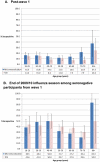Seroprevalence of pandemic influenza H1N1 in Ontario from January 2009-May 2010
- PMID: 22110586
- PMCID: PMC3215698
- DOI: 10.1371/journal.pone.0026427
Seroprevalence of pandemic influenza H1N1 in Ontario from January 2009-May 2010
Abstract
Background: We designed a seroprevalence study using multiple testing assays and population sources to estimate the community seroprevalence of pH1N1/09 and risk factors for infection before the outbreak was recognized and throughout the pandemic to the end of 2009/10 influenza season.
Methods: Residual serum specimens from five time points (between 01/2009 and 05/2010) and samples from two time points from a prospectively recruited cohort were included. The distribution of risk factors was explored in multivariate adjusted analyses using logistic regression among the cohort. Antibody levels were measured by hemagglutination inhibition (HAI) and microneutralization (MN) assays.
Results: Residual sera from 3375 patients and 1024 prospectively recruited cohort participants were analyzed. Pre-pandemic seroprevalence ranged from 2%-12% across age groups. Overall seropositivity ranged from 10%-19% post-first wave and 32%-41% by the end of the 2009/10 influenza season. Seroprevalence and risk factors differed between MN and HAI assays, particularly in older age groups and between waves. Following the H1N1 vaccination program, higher GMT were noted among vaccinated individuals. Overall, 20-30% of the population was estimated to be infected.
Conclusions: Combining population sources of sera across five time points with prospectively collected epidemiological information yielded a complete description of the evolution of pH1N1 infection.
Conflict of interest statement
Figures
References
-
- The Ontario Agency for Health Protection and Promotion and the Ontario Ministry of Health and Long-Term Care. Epidemiological summary of pandemic influenza A (H1N1) 2009 virus - Ontario, Canada, June 2009. Wkly Epidemiol Rec. 2009;84:485–491. - PubMed
-
- Ontario Ministry of Health and Long-term Care. The H1N1 Pandemic – How Ontario Fared: A Report by Ontario's Chief Medical Officer of Health. 2010. Available: http://www.health.gov.on.ca/en/public/publications/ministry_reports/cmoh.... Accessed 2011 June 10.
-
- Ontario Ministry of Health and Long-Term Care. Ontario Influenza Bulletin Surveillance Week 4 (January 24, 2010–January 30, 2009). 2010. Available: http://www.health.gov.on.ca/english/providers/program/pubhealth/flu/flu_.... Accessed 2011 June 10.
-
- World Health Organization. WHO manual on animal influenza diagnosis and surveillance. 2002. Available: http://www.who.int/csr/resources/publications/influenza/whocdscsrncs2002.... Accessed 2011 June 10.
Publication types
MeSH terms
LinkOut - more resources
Full Text Sources
Medical


